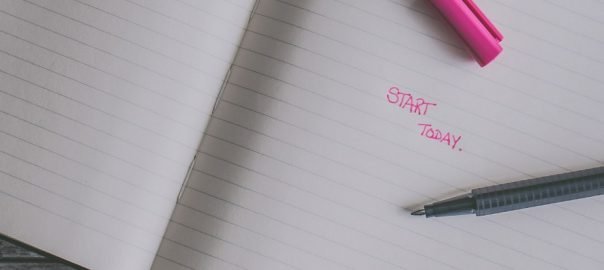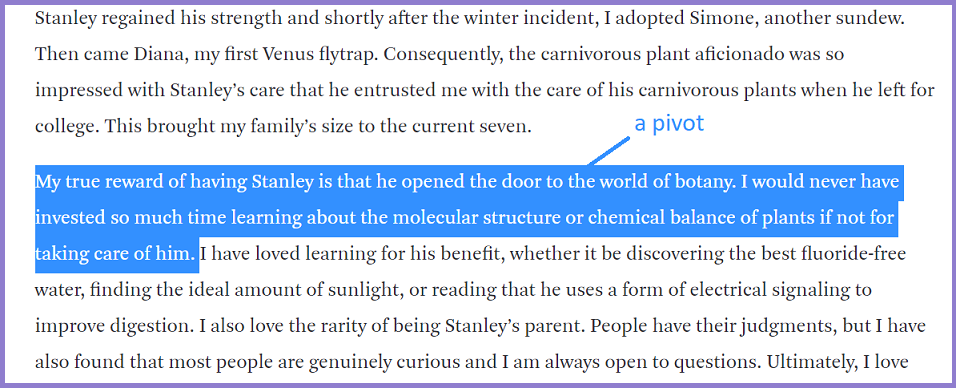
How to Start a College Essay
The most common application essay question most students ask:
How to start an essay about yourself?
Indeed, essay introductions are the most challenging part of writing for many. And while we can find tons of articles online about how to start an essay, guides on writing personal essays intros are not that frequent.
In this article, we are going to change this. Here you’ll learn good ways to start an essay about yourself.
Table of Contents:
1.Essay Introduction vs. Thesis Statement
2.The Structure of Personal Essays Introduction
3.Hooks to Use in Personal Essays
4.Pivots in Your Common Application Essay
5.How to Start an Essay: In Short
6.Key conclusions
7.Frequently asked questions

Essay Introduction vs. Thesis Statement
You know that every college essay needs a thesis statement, don’t you? It’s a central claim of what you’ll discuss in your work, and it’s a sentence or two you write at the beginning of your essay.
The problem is that many students don’t see any difference between essay introductions and thesis statements: They believe it’s the same thing.
That’s not so.
A thesis statement is a part of an introductory essay paragraph, not an introduction itself. As a rule, it closes the intro rather than substitutes it. Therefore, you have a hook, an overview, and a thesis statement in your essay’s first paragraph.
But when it comes to personal essays you write, applying to college, there won’t be any universal thesis statement in introductions. Here you’ll write a so-called pivot, a sentence or two (three maximum) where you explain how the experience you describe has shaped you.
The Structure of Personal Essays Introduction
Long story short, here go the elements of your common application essay’s introduction:
- A hook: a general statement that will evoke curiosity, build a reader’s expectations, and stimulate them to keep on reading.
- A description of your topic: what you are going to cover in your personal essay.
- A pivot: a sentence or two at the end of your introduction paragraph, where you go from a general to bigger picture. Explain how the described experience influenced and shaped you.
Example:

As far as you see from the above example, an introduction in personal essays can take more than one short paragraph. In fact, this section can be about half of your whole piece because you need to tell a brief story that gives readers the idea of what happened and how it influenced you.
And now, let’s take a closer look at how to write hooks and pivots of your common application essay’s introduction.
Hooks to Use in Personal Essays
Tim Nicholas did his best to describe the nature of writing hooks and their role in essays. He speaks about hook as the first line of your work to “really make a great impression” and “grab your reader’s attention.” Plus, Tim comes up with five useful tips on essay hooks writing:
In other words, an essay hook is either cliffhanger evoking a reader’s curiosity or scene-setting that stimulates a reader’s imagination. In both cases, it engages and encourages readers to continue examining your work.
Here are good ways to start an essay:
1) Quote
Most guides on essay hook writing recommend students to start an essay with a relevant quote of famous people. “Thanks” to this piece of advice, quotes have become so overused that teachers don’t take such openings seriously.
Quotes aren’t bad themselves. The problem is that students choose too obvious or irrelevant sayings in essays, while teachers (as well as admissions officers) want to read YOUR thoughts.
What you can do when writing a personal essay is to start it with your or someone’s quoted direct speech! It’s catchy, emotional, and it’s about your experience.
Examples:
- “You can handle it, Matt,” said Mr. Wolf, my fourth-grade band teacher, as he lifted the heavy tuba and put it into my arms.
- “On and off,” I squealed as I fiddled with every remote control device in the house—from the TV to my RC toys.
- “No, no, no, you’re all doing it wrong! The secret to developing realistic drawings lies in your ability to study every nuance of the object in front of you,” my art teacher advised. “Try sketching with one eye closed; it’s all about perspective, people!”
- “These people are just confused,” Emily whispered to me as she stared out the car window at the gay couples walking down the rainbow streets of the Castro.
Note: All the examples here and below are from jhu.edu, hamilton.edu, and stanford.edu
2) Detail
An excellent way to start an essay is a short sentence where you mention one grabby detail. It intrigues admissions officers and motivates them to keep on reading to learn more.
Examples:
- I was born with an extra hand—kind of.
- When I was in eighth grade, I couldn’t read.
- I have old hands.
- Goal: 40,000. I wrote because it made me somebody else—somebody who mattered.
- I change my name each time I place an order at Starbucks.
3) Controversial statement
A hook’s role is to grab attention and spark interest so that a person would continue reading your essay to learn more or find answers. That is why general statements don’t work here. Arguments such as “Life is wonderful,” and all this stuff are your proven way to fail.
Instead, please start your application essay with a counterintuitive sentence. Give readers something controversial or arguable so they would want to respond.
Examples:
- If string theory is really true, then the entire world is made up of strings, and I cannot tie a single one.
- Writing a college essay is an intimidating business. Just coming up with an idea, let alone writing about it, is a challenge. So, I asked for help.
4) Question
Why not start a personal essay with a direct question to readers? Just make sure it’s intriguing and specific enough to stimulate interest.
Examples:
- While traveling through the daily path of life, have you ever stumbled upon a hidden pocket of the universe?
- What does it mean to be an advocate? I didn’t find the answer in any sort of textbook.
- “If you had to choose one food to eat for the rest of your life, what would it be?”
5) The End
This hook is about starting your essay with a conclusion, a lesson you’ve learned, or a central idea you’d like to communicate to readers. And the rest of your article will be a flashback, telling about how you’ve arrived at this decision.
Examples:
- I’ve recently come to the realization that community service just isn’t for me.
- Cancer tried to defeat me, and it failed.
How Not to Start Your College Essay

An essay hook is your best chance to grab the attention of admissions officers and get the impression of the right candidate for their college. Sure thing, a hook alone can’t save the whole essay, but it needs to be strong enough for the audience to keep on reading and estimate the entire work of yours.
Here go a few writing techniques to avoid in common application essays. Overused and non creative, they’ll make most admissions officers roll their eyes heavenward.
Try not to start your essay with:
- A definition. Descriptions from online dictionaries are far from creative ideas to write in academic papers, especially in college application essays.
- An obvious thesis or general statement. The former is a kind of spoiler in your essay introduction (who wants to read a paper if you reveal everything in the first sentence?), while the later is merely dull. Leave all the exposition and arguments for the body and the conclusion of your personal essay.
- “In this essay, I’m going to tell you about…” It’s the worst option for a personal essay hook. First, you reveal the whole story at once; and second, most teachers consider this grammar construction a sign of poor writing skills.
Pivots in Your Common Application Essay
As mentioned above, a pivot is a sentence of two at the end of your essay introduction. You go from a general story to a bigger picture: What you need to do here is to illustrate what your described experience tells about you.
Example 1:

Example 2:

In other words, you need to focus on the “aha!” moment of your story in a pivot. Tell about the moment of realization, therefore moving from one part of your essay to another.
A pivot is not necessarily one sentence at the end of your first paragraph. Feel free to write two-three sentences in the middle of your article (after a hook and a description). But make sure that a pivot is what makes your story move from a general idea to a bigger one, demonstrating your concluding observations from the situation.
How to Start an Essay: In Short
If you still doubt how to start an essay about yourself, here is a short, step-by-step formula:
- Start with a hook to grab the audience and motivate them to read your story: Write a quote, a short sentence with a grabby detail, a controversial statement, or a question.
- Continue with a story itself: Describe the situation that happened.
- Finish with a pivot: Come up with a sentence or two, revealing your “aha!” moment. What was the bigger idea behind your story? Any moment of your realization there? What is the lesson you’ve learned?
And remember:
You don’t have to start with hooks or pivots once you’ve opened the document to write an essay. Tell your story first, describe the details, and then work on your first, catchy sentence to impress admissions officers.
Key conclusions
In conclusion, writing a college essay introduction is a maximally responsible assignment. You need to set the hook and get the admissions committee interested immediately. At the same time, you can’t write too broadly because you are often limited to 500 words. Try not to get too excited and, at the same time, give detailed and truthful information about yourself. This will help you get your interview right and get off to a smooth start in college. Use the guidelines, and don’t forget about the opportunity to get writing help from the authors of our service.
Frequently asked questions
The experts have tried to answer some popular questions among prospective students. We share useful information with you.
What hooks to add to the introduction essay for college?
Good college essay introduction examples always contain interesting hooks that hook the admissions committee from the first seconds of reading. It could be statistical information like the number of contests you’ve won. Or it can be a joke, a story, a description. The main thing to remember is that the central figure the narrative is about is you.
How to start an essay about yourself?
For this, you must make a work plan and, at the very beginning, try to attract readers’ attention. To do this, you can use a hook to help you captivate the admissions committee and motivate them to read your letter carefully.
Why is it important to create a good essay introduction?
First and foremost, your future studies at this institution depend on it. Such an essay lets you showcase yourself and tell useful information that will lead you to admission. Usually, such research papers are read carefully, and this will be your first impression. Try to create a great introduction to your essay.
What techniques to use for introduction to the essay?
Try to get the reader interested from the very beginning. You will be able to present your thesis statement and immediately argue it, outlining a certain structure of your paper. Focus on yourself and try to combine this with an exciting hook. In this case, you will be able to achieve success in writing the introduction.
Further reading: The Ultimate Guide to Personal Essay Writing